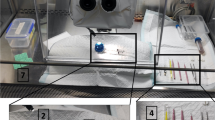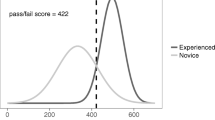Abstract
Purpose
We describe a portable practice model for acquisition of microsurgical skills using widely available inexpensive tools and materials as a model in learning ophthalmic corneal suturing skills.
Methods
Interested participants without prior microsurgery experience affiliated with the Jacobs School of Medicine and Biomedical Sciences with no prior microsurgical experience qualified to participate. Each participant completed written informed consent. We developed a 3-dimensional micro-stellated icosahedron model using microtubules, monofilament fishing line, jewelers’ forceps, and a basic laboratory dissection microscope. We tested this model in improving microsurgical skills in a randomized, controlled intervention trial. Following a pre-assessment task of passing a microsurgical needle and performing a tie, participants were randomized to a control or an intervention (building the micro-stellated icosahedrons) group. The assessment task was repeated after two weeks. Videos of pre- and post-assessments were rated by two masked ophthalmologists. Technique scores and time to complete microsurgical tasks were analyzed to determine improvement in skills.
Results
A total of 27 microsurgically naïve participants were recruited and randomized (14 Intervention / 13 Control). Comparing pre- and post-assessments, the intervention group showed significant decrease in time required to pass the needle (P = 0.018) and significant improvement in technical scores. (P = 0.001). In the control group, there was no significant decrease in time or improvement in technical scores.
Conclusions
The portable inexpensive micro-stellated icosahedron skills acquisition model is an effective practice model to acquire skills necessary to perform a microsurgical tie. The similarity in dimensions between the model and the eye suggests translatability to ophthalmic surgery.


Similar content being viewed by others
Data availability
All data are available upon request.
References
Chan WY, Matteucci P, Southern SJ (2007) Validation of microsurgical models in microsurgery training and competence: a review. Microsurgery 27(5):494–499
Dumestre D, Yeung JK, Temple-Oberle C (2014) Evidence-based microsurgical skill-acquisition series part 1: validated microsurgical models–a systematic review. J Surg Educ 71(3):329–338
Ericsson KA (2004) Deliberate practice and the acquisition and maintenance of expert performance in medicine and related domains. Acad Med 79(10 Suppl):S70-81
Ezra DG, Aggarwal R, Michaelides M et al (2009) Skills acquisition and assessment after a microsurgical skills course for ophthalmology residents. Ophthalmology 116(2):257–262
Benjamin L (2005) Selection, teaching and training in ophthalmology. Clin Exp Ophthalmol 33(5):524–530. https://doi.org/10.1111/j.1442-9071.2005.01089.x
Rali A, Fontus J, Ward L, Aaron M, Jones J, Moore E, Khalifa Y (2018) Resident stress level during steps of cataract surgery. J Acad Ophthalmol 10(01):e179–e184. https://doi.org/10.1055/s-0038-1676043
Belykh E, Byvaltsev V (2014) Off-the-job microsurgical training on dry models: Siberian experience. World Neurosurg 82(1–2):20–24
Yadav YR, Parihar V, Ratre S, Kher Y, Iqbal M (2016) Microneurosurgical Skills Training. J Neurol Surg A Cent Eur Neurosurg 77(2):146–154
Bedi MS, Bhavthankar TD, Girijala MR, Babu JK, Ambati V, Jonalgadda V, Ogando-Rivas E, Konchada K, Juluru CS, Jvnk A (2019) Lazy glass microsurgical trainer: a frugal solution for microsurgical training. World Neurosurg 125:433–442
Lannon DA, Atkins JA, Butler PE (2001) Non-vital, prosthetic, and virtual reality models of microsurgical training. Microsurgery 21(8):389–393
White CA, Wrzosek JA, Chesnutt DA, Enyedi LB, Cabrera MT (2015) A novel method for teaching key steps of strabismus surgery in the wet lab. J AAPOS 19(5):468-470.e1
Sikder S, Tuwairqi K, Al-Kahtani E, Myers WG, Banerjee P (2014) Surgical simulators in cataract surgery training. Br J Ophthalmol 98(2):154–158
Nandigam K, Soh J, Gensheimer WG, Ghazi A, Khalifa YM (2015) Cost analysis of objective resident cataract surgery assessments. J Cataract Refr Surg 41(5):997–1003
McCannel CA (2017) Continuous curvilinear capsulorhexis training and non-rhexis related vitreous loss: the specificity of virtual reality simulator surgical training (an american ophthalmological society thesis). T Am Ophthal Soc 2017(115):T2
McCannel CA, Reed DC, Goldman DR (2013) Ophthalmic surgery simulator training improves resident performance of capsulorhexis in the operating room. Ophthalmology 120(12):2456–2461
Noordzij M, Tripepi G, Dekker FW, Zoccali C, Tanck MW, Jager KJ (2010) Sample size calculations: basic principles and common pitfalls. Nephrol Dial Transplant 25(5):1388–1393
Shrout PE, Fleiss JL (1979) Intraclass correlations: uses in assessing rater reliability. Psychol Bull 86(2):420–428
Rufer F, Schroder A, Erb C (2005) White-to-white corneal diameter: normal values in healthy humans obtained with the Orbscan II topography system. Cornea 24(3):259–261
Feng MT, Belin MW, Ambrosio R Jr et al (2011) Anterior chamber depth in normal subjects by rotating scheimpflug imaging. Saudi J Ophthalmol 25(3):255–259
Rizzo JR, Beheshti M, Shafieesabet A, Fung J, Hosseini M, Rucker JC, Snyder LH, Hudson TE (2019) Eye-hand re-coordination: A pilot investigation of gaze and reach biofeedback in chronic stroke. Prog Brain Res 249:361–374
Latham AJ, Patston LL, Tippett LJ (2013) The virtual brain: 30 years of video-game play and cognitive abilities. Front Psychol 13(4):629
Jacobsen MF, Konge L, Bach-Holm D et al (2019) Correlation of virtual reality performance with real-life cataract surgery performance. J Cataract Refract Surg 45(9):1246–1251
Thomsen AS, Smith P, Subhi Y et al (2017) High correlation between performance on a virtual-reality simulator and real-life cataract surgery. Acta Ophthalmol 95(3):307–311
Bozkurt Oflaz A, Ekinci Koktekir B, Okudan S (2018) Does cataract surgery simulation correlate with real-life experience? Turk J Ophthalmol 48(3):122–126
Roohipoor R, Yaseri M, Teymourpour A, Kloek C, Miller JB, Loewenstein JI (2017) Early performance on an eye surgery simulator predicts subsequent resident surgical performance. J Surg Educ 74(6):1105–1115
Staropoli PC, Gregori NZ, Junk AK et al (2018) Surgical simulation training reduces intraoperative cataract surgery complications among residents. Simul Healthc 13(1):11–15
Lucas L, Schellini SA, Lottelli AC (2019) Complications in the first 10 phacoemulsification cataract surgeries with and without prior simulator training. Arq Bras Oftalmol 82(4):289–294
Funding
The research leading to these results received funding from in part, by the Buffalo Eye Bank Foundation Vision Research Support Fund (Buffalo, NY; support for materials and stipend, HDG-A) and facilities and resources provided by the VA Western New York Healthcare System (Buffalo, NY). Funding organization had no role in the design or conduct of this research. The contents of this work do not represent the views of the Department of Veterans Affairs or the United States government. Research reported in this publication was supported by the National Center for Advancing Translational Sciences of the National Institutes of Health under award number UL1TR001412. The content is solely the responsibility of the authors and does not necessarily represent the official views of the NIH. Funding organization had no role in the design or conduct of this research.
Author information
Authors and Affiliations
Contributions
HDG-A and SPP designed the study. HDG-A, AMF, and SPP performed the study. HDG-A, CC and JZ analyzed the data. HDG-A wrote the first draft of the manuscript which was edited by all authors. SPP supervised all stages of the study and manuscript preparation.
Corresponding author
Ethics declarations
Conflict of interest
The authors have no relevant financial or non-financial interests to disclose.
Ethical approval
This study was approved by the Institutional Review Board at the University at Buffalo (STUDY00001491) and adhered to the principles of the Declaration of Helsinki.
Consent for participate
Informed consent was obtained from all individual participants included in the study.
Additional information
Publisher's Note
Springer Nature remains neutral with regard to jurisdictional claims in published maps and institutional affiliations.
Trial Registration: ClinicalTrials.gov NCT04093063
Supplementary Information
Below is the link to the electronic supplementary material.
Instructional Video. Video presented to all participants before each pre- and post-assessment microsurgical task, explaining detailed steps on how to perform a needle pass and a microsurgical task. Format: .mp4 (MP4 13758 KB)
Rights and permissions
About this article
Cite this article
Greyner-Almeida, H.D., Mahdavi Fard, A., Chen, C. et al. A portable, low-cost practice model for microsurgical skills training. Int Ophthalmol 42, 2323–2333 (2022). https://doi.org/10.1007/s10792-022-02229-1
Received:
Accepted:
Published:
Issue Date:
DOI: https://doi.org/10.1007/s10792-022-02229-1




